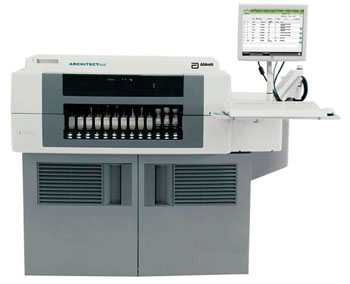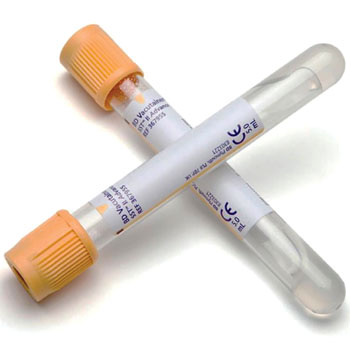Separator Tubes Assessed for Measurement of 25-Hydroxyvitamin D3
|
By LabMedica International staff writers Posted on 17 Feb 2016 |

Image: The Architect Immunoassay analyzer used for measuring 25-hydroxyvitamin D3 (25OHD3) (Photo courtesy of Abbott Diagnostics).

Image: BD serum-separating advance vacutainer tubes (SST II) (Photo courtesy of Becton Dickinson).
The accuracy of 25-hydroxyvitamin D3 (25OHD3) measurement on specimens collected into serum separator tubes (SSTs) has been questioned because of possible interference by the gel.
High performance liquid chromatography (HPLC) and liquid chromatography-tandem mass spectrometry (LC-MS/MS) are still considered the reference methods for vitamin D measurement although commercial immunoassays have been developed to satisfy increased demand for 25OHD measurement.
A team of scientists including those from the Royal Surrey County Hospital and their colleagues in Saudi Arabia collected blood specimens were from 50 healthy volunteers (22 males, 28 females, aged 42.6 ± 11.2 and BMI 27.4 ± 5.2 kg/m2), ten of whom were taking 25OHD3 supplements. Blood specimens were simultaneously collected into plain vacutainer tubes and serum-separating advance vacutainer tubes (SST II) using a standard venesection procedure. Specimens were centrifuged within one hour of blood collection and the serum transferred into secondary tubes. Serum was stored at -80 °C until analysis six months later.
All vacutainers used were from Becton Dickinson (BD; Franklin Lakes, NJ, USA) and 25OHD3 was assayed on serum using high performance liquid chromatography (Waters Corporation; Milford, MA, USA), and immunoassays from Architect (Abbott Diagnostics; Abbott Park, IL, USA) and Liaison (DiaSorin; Saluggia, Italy).
The authors found there were no significant differences between 25OHD3 results (means ± SE, nmol/l) obtained from specimens collected into plain tubes and SSTs assayed by HPLC (39.0 ± 2.7 vs. 39.3 ± 2.7), Liaison (32.9 ± 2.2 vs. 32.8 ± 2.3), or Architect (43.1 ± 2.8 vs. 43.2 ± 2.8). In specimens collected into plain tubes and SSTs, 25OHD3 measurements by HPLC correlated significantly with those from the Architect and Liaison respectively.
The authors concluded that the gel in BD’s SSTs does not interfere with the measurement of 25OHD3 by HPLC or by the commercial immunoassays tested. This important finding may enable clinical laboratories to make cost savings by using SSTs without concerns about inaccuracy. The study was published in the January 2016 issue of the Journal of Clinical Laboratory Analysis.
Related Links:
Royal Surrey County Hospital
Becton Dickinson
Waters Corporation
High performance liquid chromatography (HPLC) and liquid chromatography-tandem mass spectrometry (LC-MS/MS) are still considered the reference methods for vitamin D measurement although commercial immunoassays have been developed to satisfy increased demand for 25OHD measurement.
A team of scientists including those from the Royal Surrey County Hospital and their colleagues in Saudi Arabia collected blood specimens were from 50 healthy volunteers (22 males, 28 females, aged 42.6 ± 11.2 and BMI 27.4 ± 5.2 kg/m2), ten of whom were taking 25OHD3 supplements. Blood specimens were simultaneously collected into plain vacutainer tubes and serum-separating advance vacutainer tubes (SST II) using a standard venesection procedure. Specimens were centrifuged within one hour of blood collection and the serum transferred into secondary tubes. Serum was stored at -80 °C until analysis six months later.
All vacutainers used were from Becton Dickinson (BD; Franklin Lakes, NJ, USA) and 25OHD3 was assayed on serum using high performance liquid chromatography (Waters Corporation; Milford, MA, USA), and immunoassays from Architect (Abbott Diagnostics; Abbott Park, IL, USA) and Liaison (DiaSorin; Saluggia, Italy).
The authors found there were no significant differences between 25OHD3 results (means ± SE, nmol/l) obtained from specimens collected into plain tubes and SSTs assayed by HPLC (39.0 ± 2.7 vs. 39.3 ± 2.7), Liaison (32.9 ± 2.2 vs. 32.8 ± 2.3), or Architect (43.1 ± 2.8 vs. 43.2 ± 2.8). In specimens collected into plain tubes and SSTs, 25OHD3 measurements by HPLC correlated significantly with those from the Architect and Liaison respectively.
The authors concluded that the gel in BD’s SSTs does not interfere with the measurement of 25OHD3 by HPLC or by the commercial immunoassays tested. This important finding may enable clinical laboratories to make cost savings by using SSTs without concerns about inaccuracy. The study was published in the January 2016 issue of the Journal of Clinical Laboratory Analysis.
Related Links:
Royal Surrey County Hospital
Becton Dickinson
Waters Corporation
Latest Clinical Chem. News
- Carbon Nanotubes Help Build Highly Accurate Sensors for Continuous Health Monitoring
- Paper-Based Device Boosts HIV Test Accuracy from Dried Blood Samples
- AI-Powered Raman Spectroscopy Method Enables Rapid Drug Detection in Blood
- Novel LC-MS/MS Assay Detects Low Creatinine in Sweat and Saliva
- Biosensing Technology Breakthrough Paves Way for New Methods of Early Disease Detection
- New Saliva Test Rapidly Identifies Paracetamol Overdose
- POC Saliva Testing Device Predicts Heart Failure in 15 Minutes

- Screening Tool Detects Multiple Health Conditions from Single Blood Drop
- Integrated Chemistry and Immunoassay Analyzer with Extensive Assay Menu Offers Flexibility, Scalability and Data Commutability
- Rapid Drug Test to Improve Treatment for Patients Presenting to Hospital
- AI Model Detects Cancer at Lightning Speed through Sugar Analyses
- First-Ever Blood-Powered Chip Offers Real-Time Health Monitoring
- New ADLM Guidance Provides Expert Recommendations on Clinical Testing For Respiratory Viral Infections
- 3D Printed Point-Of-Care Mass Spectrometer Outperforms State-Of-The-Art Models
- POC Biomedical Test Spins Water Droplet Using Sound Waves for Cancer Detection
- Highly Reliable Cell-Based Assay Enables Accurate Diagnosis of Endocrine Diseases
Channels
Molecular Diagnostics
view channel
RNA-Based Blood Test Detects Preeclampsia Risk Months Before Symptoms
Preeclampsia remains a major cause of maternal morbidity and mortality, as well as preterm births. Despite current guidelines that aim to identify pregnant women at increased risk of preeclampsia using... Read more
First Of Its Kind Test Uses microRNAs to Predict Toxicity from Cancer Therapy
Many men with early-stage prostate cancer receive stereotactic body radiotherapy (SBRT), a highly precise form of radiation treatment that is completed in just five sessions. Compared to traditional radiation,... Read moreNovel Cell-Based Assay Provides Sensitive and Specific Autoantibody Detection in Demyelination
Anti-myelin-associated glycoprotein (MAG) antibodies serve as markers for an autoimmune demyelinating disorder that affects the peripheral nervous system, leading to sensory impairment. Anti-MAG-IgM antibodies... Read moreHematology
view channel
New Scoring System Predicts Risk of Developing Cancer from Common Blood Disorder
Clonal cytopenia of undetermined significance (CCUS) is a blood disorder commonly found in older adults, characterized by mutations in blood cells and a low blood count, but without any obvious cause or... Read more
Non-Invasive Prenatal Test for Fetal RhD Status Demonstrates 100% Accuracy
In the United States, approximately 15% of pregnant individuals are RhD-negative. However, in about 40% of these cases, the fetus is also RhD-negative, making the administration of RhoGAM unnecessary.... Read moreImmunology
view channel
Stem Cell Test Predicts Treatment Outcome for Patients with Platinum-Resistant Ovarian Cancer
Epithelial ovarian cancer frequently responds to chemotherapy initially, but eventually, the tumor develops resistance to the therapy, leading to regrowth. This resistance is partially due to the activation... Read more
Machine Learning-Enabled Blood Test Predicts Immunotherapy Response in Lymphoma Patients
Chimeric antigen receptor (CAR) T-cell therapy has emerged as one of the most promising recent developments in the treatment of blood cancers. However, over half of non-Hodgkin lymphoma (NHL) patients... Read moreMicrobiology
view channel
Handheld Device Deliver Low-Cost TB Results in Less Than One Hour
Tuberculosis (TB) remains the deadliest infectious disease globally, affecting an estimated 10 million people annually. In 2021, about 4.2 million TB cases went undiagnosed or unreported, mainly due to... Read more
New AI-Based Method Improves Diagnosis of Drug-Resistant Infections
Drug-resistant infections, particularly those caused by deadly bacteria like tuberculosis and staphylococcus, are rapidly emerging as a global health emergency. These infections are more difficult to treat,... Read more
Breakthrough Diagnostic Technology Identifies Bacterial Infections with Almost 100% Accuracy within Three Hours
Rapid and precise identification of pathogenic microbes in patient samples is essential for the effective treatment of acute infectious diseases, such as sepsis. The fluorescence in situ hybridization... Read morePathology
view channel
Advanced Imaging Reveals Mechanisms Causing Autoimmune Disease
Myasthenia gravis, an autoimmune disease, leads to muscle weakness that can affect a range of muscles, including those needed for basic actions like blinking, smiling, or moving. Researchers have long... Read more
AI Model Effectively Predicts Patient Outcomes in Common Lung Cancer Type
Lung adenocarcinoma, the most common form of non-small cell lung cancer (NSCLC), typically adopts one of six distinct growth patterns, often combining multiple patterns within a single tumor.... Read moreTechnology
view channel
Pain-On-A-Chip Microfluidic Device Determines Types of Chronic Pain from Blood Samples
Chronic pain is a widespread condition that remains difficult to manage, and existing clinical methods for its treatment rely largely on self-reporting, which can be subjective and especially problematic... Read more
Innovative, Label-Free Ratiometric Fluorosensor Enables More Sensitive Viral RNA Detection
Viruses present a major global health risk, as demonstrated by recent pandemics, making early detection and identification essential for preventing new outbreaks. While traditional detection methods are... Read moreIndustry
view channel
Cepheid and Oxford Nanopore Technologies Partner on Advancing Automated Sequencing-Based Solutions
Cepheid (Sunnyvale, CA, USA), a leading molecular diagnostics company, and Oxford Nanopore Technologies (Oxford, UK), the company behind a new generation of sequencing-based molecular analysis technologies,... Read more
Grifols and Tecan’s IBL Collaborate on Advanced Biomarker Panels
Grifols (Barcelona, Spain), one of the world’s leading producers of plasma-derived medicines and innovative diagnostic solutions, is expanding its offer in clinical diagnostics through a strategic partnership... Read more






















